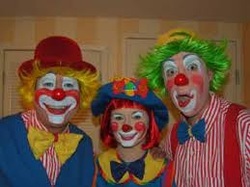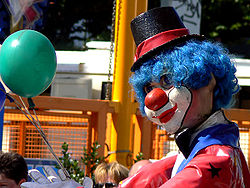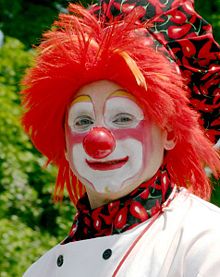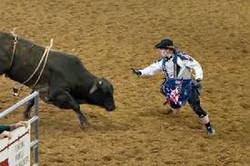About clowns

Clowns are comical performers, stereotypically characterized by the image of the Circus clown and their grotesque appearances: colored wigs,stylistic makeup, outlandish costumes, unusually large footwear, red-nose, etc. (which evolved to project their actions to very large audiences), who entertain spectators by acting in a hilarious fashion. The types of their acts varies greatly. Although a few people find clowns to be scary, their aim is to entertain people. Other less grotesque styles have also developed which include theatre, TV and Film Clowns. Peter Berger writes that "It seems plausible that folly and fools, like religion and magic, meet some deeply rooted needs in human society." For this reason, clowning is often considered an important part of training as a physical performance discipline, partly because tricky subject matter can be dealt with, but also because it requires a high level of risk and play in the performer.
History of Clowns In Europe
Clowning was developed from a broad tradition of historical performances, and it is difficult to point out a singular tradition or even a few different ones as being the primary precursors to clowns. However there are a few past prominent forms of entertainment contemporarily linked to clowning as its possible antecedents.
Examples of historical, "clown-like" comedic performers have been the pantomimus in ancient Greece, the Lazzi of Commedia dell'Arte,bouffons, court jesters, as well as the French mime tradition. On top of this there are many non-European clowning traditions (including clown-like figures in Japanese Kabuki theatre), North American native shamen traditons to consider which may or may not have influenced what we now think of as a clown in the western world.
Examples of historical, "clown-like" comedic performers have been the pantomimus in ancient Greece, the Lazzi of Commedia dell'Arte,bouffons, court jesters, as well as the French mime tradition. On top of this there are many non-European clowning traditions (including clown-like figures in Japanese Kabuki theatre), North American native shamen traditons to consider which may or may not have influenced what we now think of as a clown in the western world.
Principal clown types
A whiteface character does not always wear the classic whiteface makeup. Additionally, a character can wear traditional whiteface makeup and be an auguste.

Classic appearance. Traditionally, the whiteface clown uses "clown white" makeup to cover his or her entire face and neck with none of the underlying flesh color showing. In the European whiteface makeup, the ears are painted red. Features, in red and black, are delicate. He or she is traditionally costumed far more extravagantly than the other two clown types, sometimes wearing the ruffled collar and pointed hat which typify the stereotypical "clown suit".

The Clown and the tightrope walker
Character. The whiteface character-type is often serious, all-knowing (even if not particularly smart), bossy and cocky. He is the ultimate authority figure. He serves the role of "straight-man" and sets up situations that can be turned funny.
Some circus examples include Pipo Sossman, François Fratellini (the Fratellini family), Felix Adler, Paul Jung, Harry Dann, Chuck Burnes, Albert White, Ernie Burch, Bobby Kaye, Jack and Jackie LeClaire, Joe and Chester Sherman, Keith Crary, Charlie Bell, Tim Tegge, Kenny Dodd, Frankie Saluto, Tammy Parish, David Konyot (Circus Barum and The Toni Alexis trio), Jay Stewart and Prince Paul Albert.
Auguste
Appearance
The auguste face base makeup color is a variation of pink, red, or tan rather than white. Features are exaggerated in size and are typically red and black in color. The mouth is thickly outlined with white (called the muzzle) as are the eyes. The auguste is dressed (appropriate to character) in either well-fitted garb or in a costume that does not fit – either oversize or too small is appropriate. Bold colors, large prints or patterns, and suspenders often characterize auguste costumes.
Character
The auguste character-type is often an anarchist, a joker, or a fool. He is clever and has much lower status than the whiteface. Classically the whiteface character instructs the auguste character to perform his bidding. The auguste has a hard time performing the task given which leads to funny situations. Sometimes the auguste plays the role of an anarchist and purposefully has trouble following the whiteface's directions. Sometimes the auguste is confused or is foolish and is screwing up less deliberately.
The contra-auguste
The contra-auguste plays the role of the mediator between the whiteface character and the auguste character. He has a lower status than the whiteface but a higher status than the auguste. He aspires to be more like the whiteface and often mimics everything the whiteface does to try to gain approval. If there is a contra-auguste character, he often is instructed by the whiteface to correct the auguste when he is doing something wrong.
Some circus examples include Pipo Sossman, François Fratellini (the Fratellini family), Felix Adler, Paul Jung, Harry Dann, Chuck Burnes, Albert White, Ernie Burch, Bobby Kaye, Jack and Jackie LeClaire, Joe and Chester Sherman, Keith Crary, Charlie Bell, Tim Tegge, Kenny Dodd, Frankie Saluto, Tammy Parish, David Konyot (Circus Barum and The Toni Alexis trio), Jay Stewart and Prince Paul Albert.
Auguste
Appearance
The auguste face base makeup color is a variation of pink, red, or tan rather than white. Features are exaggerated in size and are typically red and black in color. The mouth is thickly outlined with white (called the muzzle) as are the eyes. The auguste is dressed (appropriate to character) in either well-fitted garb or in a costume that does not fit – either oversize or too small is appropriate. Bold colors, large prints or patterns, and suspenders often characterize auguste costumes.
Character
The auguste character-type is often an anarchist, a joker, or a fool. He is clever and has much lower status than the whiteface. Classically the whiteface character instructs the auguste character to perform his bidding. The auguste has a hard time performing the task given which leads to funny situations. Sometimes the auguste plays the role of an anarchist and purposefully has trouble following the whiteface's directions. Sometimes the auguste is confused or is foolish and is screwing up less deliberately.
The contra-auguste
The contra-auguste plays the role of the mediator between the whiteface character and the auguste character. He has a lower status than the whiteface but a higher status than the auguste. He aspires to be more like the whiteface and often mimics everything the whiteface does to try to gain approval. If there is a contra-auguste character, he often is instructed by the whiteface to correct the auguste when he is doing something wrong.
Character clown

Clown Chili Peppers
The character clown adopts an eccentric character of some type, such as a butcher, a baker, a policeman, a housewife or hobo. Prime examples of this type of clown are the circus tramps Otto Griebling and Emmett Kelly. Red Skelton, Harold Lloyd, Buster Keaton, and Charlie Chaplin would all fit the definition of a character clown.
The character clown makeup is a comic slant on the standard human face. Their makeup starts with a flesh tone base and may make use of anything from glasses, mustaches and beards to freckles, warts, big ears or strange haircuts.
North American character clown types The most prevalent character clown in the American circus is the hobo, tramp or bum clown. There are subtle differences in the American character clown types. The primary differences among these clown types is attitude. According to American circus expert Hovey Burgess, they are (in order of class):
Native American clowning Many Native Tribes have a history of clowning. The Canadian Clowning method developed by Richard Pochinko and furthered by his former apprentice, Sue Morrison, combines European and Native American clowning techniques.
In this tradition, masks are made of clay while the creator's eyes are closed. A mask is made for each direction of the medicine wheel. During this process, the clown creates a personal mythology which explores his or her personal Experiences and Innocenses
The character clown makeup is a comic slant on the standard human face. Their makeup starts with a flesh tone base and may make use of anything from glasses, mustaches and beards to freckles, warts, big ears or strange haircuts.
North American character clown types The most prevalent character clown in the American circus is the hobo, tramp or bum clown. There are subtle differences in the American character clown types. The primary differences among these clown types is attitude. According to American circus expert Hovey Burgess, they are (in order of class):
- The Hobo Migratory and finds work where he travels. Down on his luck but maintains a positive attitude.
- The Tramp Migratory and does not work where he travels. Down on his luck and depressed about his situation.
- The Bum Non-migratory and non-working.
Native American clowning Many Native Tribes have a history of clowning. The Canadian Clowning method developed by Richard Pochinko and furthered by his former apprentice, Sue Morrison, combines European and Native American clowning techniques.
In this tradition, masks are made of clay while the creator's eyes are closed. A mask is made for each direction of the medicine wheel. During this process, the clown creates a personal mythology which explores his or her personal Experiences and Innocenses

Rodeo clown
A rodeo clown is a cowboy, or animal wrangler, dressed in wild costumes. They are used in bull riding riding competitions where their primary job is to distract the bull from the rider when the rider dismounts either at the conclusion of the ride (typically 8 seconds) or by being thrown before the conclusion of the ride. Rodeo Clowns are also referred to as bull fighters and cowboy protection within rodeo circles. Rodeo Clowns usually work in pairs or in threes and move towards the bull, waving and yelling to attract the bull's attention to themselves as soon as a bull rider dismounts or is thrown from the bull. This action allows the rider to escape to safety. In situations where a rider becomes entangled and unable to free him or herself from the bull, the Rodeo Clowns put themselves at risk by rushing to the bull and placing themselves between the bull's horns and rider while at the same time attempting to free the rider from bull. Many modern rodeos will showcase Rodeo Clowns by featuring them in a segment separate from bull riding where the 'clowns' demonstrate their bull fighting prowess by directly confronting bulls, jumping over them and using other specialized evasive maneuvers.
A rodeo clown is a cowboy, or animal wrangler, dressed in wild costumes. They are used in bull riding riding competitions where their primary job is to distract the bull from the rider when the rider dismounts either at the conclusion of the ride (typically 8 seconds) or by being thrown before the conclusion of the ride. Rodeo Clowns are also referred to as bull fighters and cowboy protection within rodeo circles. Rodeo Clowns usually work in pairs or in threes and move towards the bull, waving and yelling to attract the bull's attention to themselves as soon as a bull rider dismounts or is thrown from the bull. This action allows the rider to escape to safety. In situations where a rider becomes entangled and unable to free him or herself from the bull, the Rodeo Clowns put themselves at risk by rushing to the bull and placing themselves between the bull's horns and rider while at the same time attempting to free the rider from bull. Many modern rodeos will showcase Rodeo Clowns by featuring them in a segment separate from bull riding where the 'clowns' demonstrate their bull fighting prowess by directly confronting bulls, jumping over them and using other specialized evasive maneuvers.
